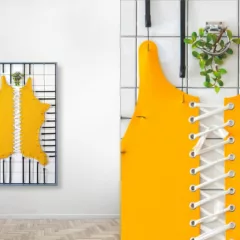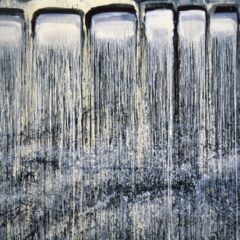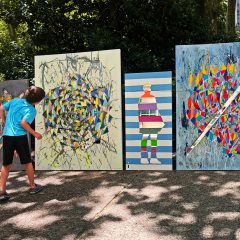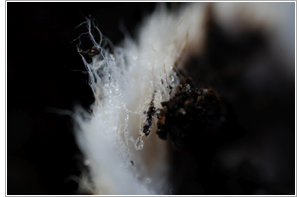
Louise Barteau Chodoff’s exhibition at the Abington Art Center follows the second part of her ongoing project, Grove, which opened with an installation, In an instant, everything changes, at The Media Bureau last September. It included two videos, with imagery shot in Fairmount Park, projected onto a group of papier mache trees as well as an original sound tract created by Simon Rogers (click here for post on the installation).

Barteau-Chodoff instructing friends and neighbors about siting the trees in Carpenter’s woods for the second part of her project, Grove; November 2007, photo Andrea Kirsh
The second part of the project, It’s Always Hard to Say Good-bye, began on a Sunday morning early last November when more than 30 supporters joined Barteau Chodoff to site the hollow, papier mache trees from the installation in a clearing in Carpenter’s Woods in Mt. Airy. The group included friends and neighbors of the artist, colleagues from the arts community and a group from Friends of Carpenter’s Woods. They carried the trees to an area that Chodoff and fellow Friends had cleared of invasive Japanese Knotweed and English Ivy and will ultimately be the site of a new stand of oaks. Placing the hollow trees, made of cast Abaco fibre, and filling them with fresh soil was a group project. Figuring out how to fill and stabilize the trees was an empirical process, but with enough shovels, buckets, ladders, improvised funnels and hands it was finished in about an hour.

A young volunteer working on the project, November 2007, photo Andrea Kirsh
Barteau Chodoff has documented the process of the trees’ decomposition, and one of the two digital displays at Abington features images of the trees being sited in the woods; the other shows a sequence of details of the trees’ collapse and decay. The details were taken at such close range that it’s hard to distinguish bits of Abaco fibre from snow crystals, but the images convey the intensity of sunshine reflected in the snow and the narrow chromatic range of the woods in winter. The initial installation of Grove created a virtual woodland which encouraged viewers to linger and observe the changing light caused by cloud movements. The sequence of details on view at Abington recreates some of the glimpses offered to dog-walkers and others who pass through Carpenter’s Woods on a regular basis. This section of Grove is more than a metaphor of the cycles of nature; it is a synchronous process that brackets the natural woodland decay that surrounds it. The artist’s website chronicles the project on an ongoing basis.
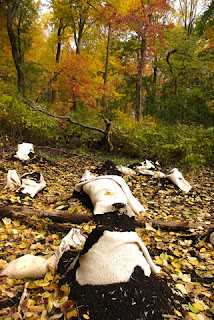
Part 2 of Grove in Carpenter’s Woods, after the trees had collapsed and are beginning to decay, photo by the artist
February Solo Series at Abington

Nyugen Smith Bundle House FS#2 2008, found materials, photo by the artist
Barteau-Chodoff’s is one of four concurrent and very diverse solo exhibitions at the Abington Art Center through March 1. Rosalyn Richards is showing paintings, drawings and prints which offer microscopic views of natural growth. The pencil drawings are particularly strong; delicate and substantial at the same time, they bring to mind the knotted and net-like structures employed by sculptors such as Gego and Mona Hatoum. Danielle Bursk’s ink drawings consist of accumulations of strokes that create a prickly quality. The three monumental drawings on mylar evoked large piles of indeterminate substance, as if they were studies for three-dimensional works. Nyugen Smith has filled a large room with huts made from colorful materials culled from the garbage dump. This architecture of collage and reclamation refers at once to the material poverty and the imaginative riches of structures the artist saw in West Africa; it makes an interesting comparison with Earl Fyffe‘s Shanty, another work based on improvised vernacular housing, currently on view in From Taboo to Icon; Africanist Turnabout at the Icebox.


